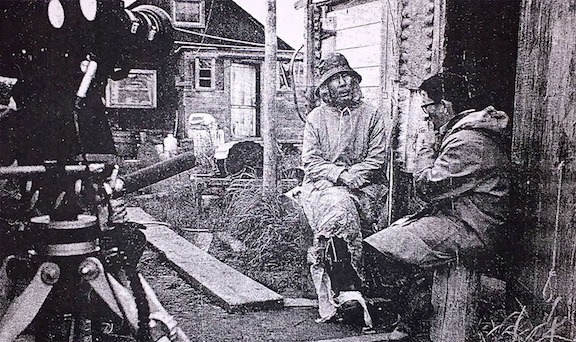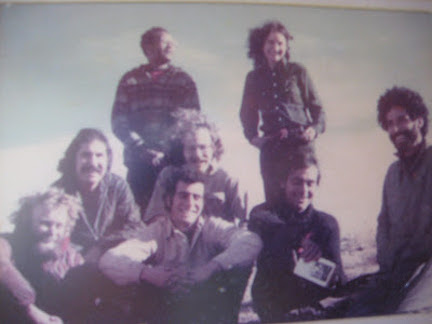Click here to print
NFPF Awards Grants to 35 Institutions
posted August 23, 2019
The National Film Preservation Foundation has announced [in July] grants to 35 institutions to save 74 films.
Since Congress created the NFPF in 1996, the agency has provided preservation support through grants and collaborative projects to 304 institutions to preserve 2,478 films.
Funding for the grants comes from allocations through The Library of Congress Sound Recording and Film Preservation Programs Reauthorization Act of 2016 as well as donations.
The NFPF preservation grants target newsreels, silent-era films, culturally important home movies, avant-garde films, and endangered independent productions that are unlikely to be preserved by commercial programs.
The awards enable recipients to create a film preservation master and two access copies of each work for use in education, screenings, exhibits, DVDs, television broadcasts, and the Internet.
A selection of preserved films is on the NFPF website, and grant recipients have made more than 230 additional titles accessible.
Institutions to which awards were made this year, and their selected films, were:
Alaska Moving Image Preservation Association: Three of 30 participatory films produced in the Yup’ik village of Emmonak, on the delta of the Yukon River, in western Alaska, by the Community Enterprise Development Corporation (CEDC) of Alaska’s SKYRIVER Lower Yukon Project (c. 1970-73). Rather than documentaries, the films were experiments in using media production as a vehicle for community development. SKYRIVER made very few copies, so surviving prints are generally worn due to heavy use. The restorations will make use of original production elements such as black-and-white negatives, which Alaska Village Initiatives, the administrative successor to CEDC, gave to AMIPA in 1998. The films depict, for example, concern for the loss of traditional knowledge following 50 years of rapid cultural change, the role of the arrival of electricity in sparking such concerns, and the trauma that rural Alaska Native families experienced when they sent their children to borading schools for a high school education. AMIPA will distribute DVD copies of the restored films to civic and cultural institutions in Emmonak and nearby communities.
Electricity Comes to the Village (ca. 1971), community-produced film from the Yup’ik village of Emmonak, used to express local concerns to the public utility.
Francis Lee: Eskimo Life on the Yukon Delta (ca. 1970), documentation of a Yup’ik village elder lamenting the loss of native ways.
William Trader: Children Leave for School (ca. 1971), successful film protest of the child separation policy inflicted by state government upon Native families in rural Alaska.
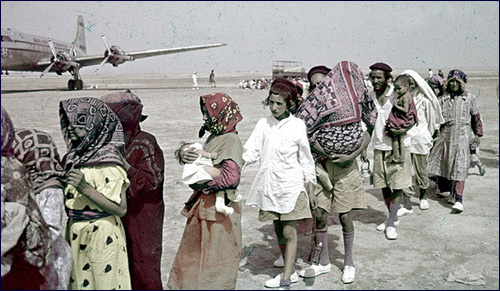 American Jewish Joint Distribution Committee
American Jewish Joint Distribution Committee
Immigration of Yemenite Jews to Israel (1949), footage taken by the president of Alaska Airlines of the Operation Magic Carpet airlift mission, which transported 49,000 Yemenites.
Paris Travelogue, April 1948 (1948), footage of the Jewish Distribution Committee’s Paris conference to assess the conditions of Holocaust survivors in Displaced Persons camps.
American Museum of Natural History
The Scientific Expedition to the South Pacific in the Yacht Zaca (1934–35), documentation of the AMNH Templeton Crocker Expedition of 1934–35 by California Academy of Sciences artist Toshio Asaeda.
Anthology Film Archives
The Films of Victor Grauer (1965–78), 25 stroboscopic, structural, and minimalist works by the “neo-modernist” filmmaker.
ASIFA-Hollywood
Not Wedded But a Wife (1921), Mutt and Jeff cartoon released by Fox.
Bridgeport Public Library
Bridgeport, Connecticut in the Blizzard of 1934 (1934), amateur footage of the snowstorm that buried Bridgeport under 28 inches of snow.
Bruce Museum
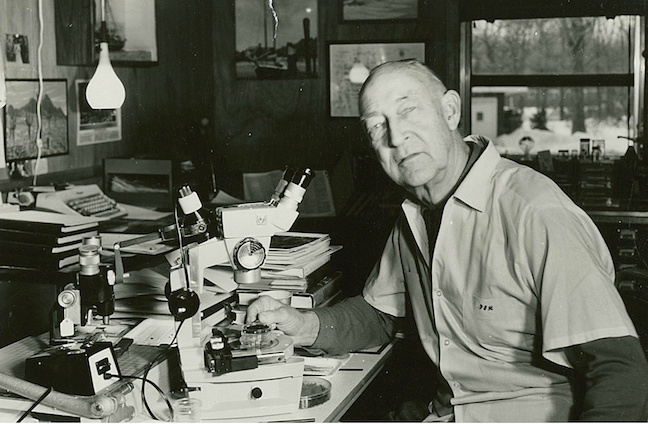 Canyons in the Making (ca. 1948–50), and three other 16mm films by naturalist Paul G. Howes, all held at the Bruce Museum. Canyons is a 10-minute color instructional film that uses the Grand Canyon to teach about geological processes. Also to be preserved are two nature films by Howes: Four Seasons, Part II: Winter (ca. 1950s), a silent, black-and-white film from a series chronicling seasonal variations, and Let the Birds Tell It All (1957–58), the latter a 25-minute color film in which familiar species explain life from their point of view;and one Howes instructional film, Observing As You Go (1957), a 25-minute color film about being alert to natural phenomena. Howes, a native of Stamford, CT, was one of the leading naturalists of his day.Beginning in 1913, he made several expeditions in the Americas. He deposited his natural-history collections in the Bruce Museum, in Greenwich, CT, which he curated for many years. He made dozens of natural-history and geographical dioramas and 14 color films about biology and travel, and wrote many books. The Bruce Museum has four other films by Howes, as well as 16 reel-to-reel audio tapes that the Bruce will preserve and digitize when funding permits.
Canyons in the Making (ca. 1948–50), and three other 16mm films by naturalist Paul G. Howes, all held at the Bruce Museum. Canyons is a 10-minute color instructional film that uses the Grand Canyon to teach about geological processes. Also to be preserved are two nature films by Howes: Four Seasons, Part II: Winter (ca. 1950s), a silent, black-and-white film from a series chronicling seasonal variations, and Let the Birds Tell It All (1957–58), the latter a 25-minute color film in which familiar species explain life from their point of view;and one Howes instructional film, Observing As You Go (1957), a 25-minute color film about being alert to natural phenomena. Howes, a native of Stamford, CT, was one of the leading naturalists of his day.Beginning in 1913, he made several expeditions in the Americas. He deposited his natural-history collections in the Bruce Museum, in Greenwich, CT, which he curated for many years. He made dozens of natural-history and geographical dioramas and 14 color films about biology and travel, and wrote many books. The Bruce Museum has four other films by Howes, as well as 16 reel-to-reel audio tapes that the Bruce will preserve and digitize when funding permits.
Chicago Film Archives
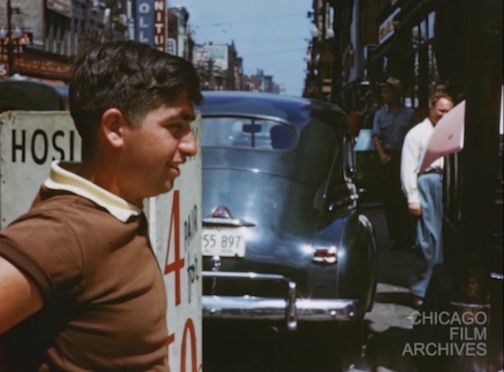 Camera on Chicago (1940–83), documentation of Chicago’s changing face and cultural diversity by amateur filmmaker Warren Thompson. Camera on Chicago was filmed from 1949 to 1983. Thompson documents the intense post-war growth of the city through shots of everyday Chicago life. The film shows the changing architecture of the skyline and neighborhoods; shots of workers at the stockyards, construction sites, and smiths who made horse shoes; traffic on Lake Shore Drive; leisure activities at the lake front such as fishing and sunbathing; State Street at night including an exterior shot of the now-defunct United Artists Theatre promoting the world-premiere of Alfred Hitchcock’s “North By NorthWest”; vibrant ethnic neighborhoods like Maxwell St. and Chinatown; ships at Navy Pier; the Water Tower covered in Christmas lights; and the construction of the Hancock Building.
Camera on Chicago (1940–83), documentation of Chicago’s changing face and cultural diversity by amateur filmmaker Warren Thompson. Camera on Chicago was filmed from 1949 to 1983. Thompson documents the intense post-war growth of the city through shots of everyday Chicago life. The film shows the changing architecture of the skyline and neighborhoods; shots of workers at the stockyards, construction sites, and smiths who made horse shoes; traffic on Lake Shore Drive; leisure activities at the lake front such as fishing and sunbathing; State Street at night including an exterior shot of the now-defunct United Artists Theatre promoting the world-premiere of Alfred Hitchcock’s “North By NorthWest”; vibrant ethnic neighborhoods like Maxwell St. and Chinatown; ships at Navy Pier; the Water Tower covered in Christmas lights; and the construction of the Hancock Building.
On the Shores of Lake Michigan (1948), travelogue of the region’s touristic and industrial highlights by Illinois photographer Julian Gromer.
Chicago Film Society
Bathroom (1969), Fred Camper’s 25-minute, 16mm, silent structural film study of a boarding house restroom (Chicago Film Society). In his youth and early adulthood, Camper, a Chicago artist, writer, and lecturer on film, art, and photography, made five 16mm films, and by 1984 had made a version of his full-length SN. By then, he writes on his website, “my film ideas had grown impossibly ambitious in comparison to my resources, while I had already, for other reasons, been thinking about combining multiple still photographs in ways that would be somewhat cinematic, something I continued to think about for two decades.”
Doll Messengers of Friendship (1929), a sponsored documentary film of a 1920s good-will doll exchange between the U.S. and Japan, initiated by the Committee on World Friendship Among Children.
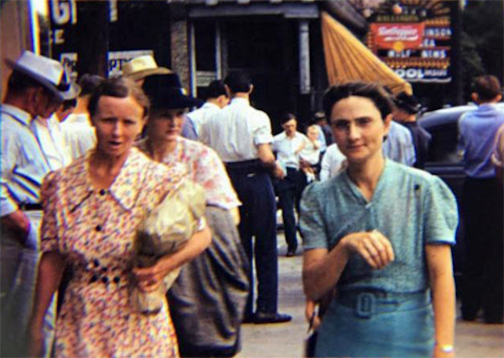 Christian & Missionary Alliance
Christian & Missionary Alliance
Entering the Valley That Time Forgot (1954), footage of the CMA’s first contact with the Dani Tribes of Papua, Indonesia, in 1954.
East Carolina University
Greenville in Reelife (1941, right), a color, silent, 16mm town portrait of Greenville, North Carolina.
Dink: Pre-Blues Musician (1975), scholar Cecelia Conway’s portrait and performance film of African American banjo player Dink Roberts, illustrating what the pre-blues tradition might have been like.
Frelinghuysen Morris House & Studio
Travel Films of George L.K. Morris (1934), home movies of the abstract painter’s travels through Indonesia, Myanmar, and Thailand, held at the Lenox, Massachusetts institution, which commemorates the work of George L. K. Morris and Suzy Frelinghuysen, prolific abstract artists since the late 1930s.
George Eastman Museum
Bringin’ Home the Bacon (1924), Western feature directed by Richard Thorpe, starring “Buffalo Bill Jr.” and Jean Arthur.
A Sleeping Memory (1917), Metro Pictures melodrama involving brain surgery, hypnosis, and past lives, based on the E. Phillips Oppenheim novel.
Anonymous Artists of America (1969–70, right), footage of an outdoor concert at the University of Chicago by the eponymous psychedelic rock collective. Also, Hum 255 (1970), filmed discussion of political activism led by students expelled after the 1968 strike at the University of Chicago. Also, What the F*%k Are These Red Squares? (1970), documentation of a “Revolutionary Seminar” teach-in held during a teacher/student strike at the Art Institute of Chicago.
Mid-Atlantic Regional Moving Image Archive
The Fitzgeralds in Hollywood (1927), footage of Zelda and F. Scott Fitzgerald, along with actresses Lois Moran and Carmel Myers, held at the Baltimore, Md. institution.
Michigan Technological University
Winter Carnival Films (ca. 1970s), documentation of Michigan Tech’s longest running cultural tradition.
Montana Historical Society
Daly Family Collection, Part 2 (1919–21), home movies of leisure activities enjoyed by the founding family of the Anaconda Copper Mining Company at the Daly Mansion.
Museum of International Folk Art
Prewar Peasants of Central Europe (1938), art collector Clara Hoover’s documentation of an intensive folk art workshop spread across Hungary.
Museum of Texas Tech University
Yaqui Fieldwork Collection, Part 2 (1953–55), anthropologist Robert Ravicz’s documentation of Yaqui village life and Fiesta de Gloria celebrations in Sonora.
National Geographic Society
Dzibilchaltún Archaeological Expeditions (1957–60), lecture film by E. Wyllys Andrews of the NGS–Tulane University expedition that excavated one of the largest Mayan sites on the Yucatán peninsula.
Oklahoma State University
Flying Farmers (1947–49), documentation of conventions held in Oklahoma by the national association of farmers who utilized aircraft, staged as part of OSU’s Farm and Home Week. OSU’s earlier incarnation, Oklahoma A&M College, set up the Oklahoma Flying Farmers Association in 1944. Among is events was an annual “fly-in” that would allow the flying farmers to take their non-flying counterparts up for a view to compare farmlands and consider soil conservation techniques.
Phoenix Arts Alliance
Three films by experimental filmmaker Beryl Sokoloff, a New York artist/filmmaker who died in 2006, largely forgotten, but whose reputation has since revived. He made dozens of lyrical, non-narrative films, edited to draw together visual and psychological patterns.
France III (1961), her portrait of a nation in turmoil; Love (1960), her exploration of the streets of New York; and Travers (1961), an abstract study of light and pattern and of nature and artifice.
(Below, a clip from a Sokoloff film from about the same time, My Mirrored Hope (1963).)
Pueblo City-County Library District
Frank D. Muramoto Collection (ca. 1930s–40s), home movies by the owner of a photography studio in Pueblo, Colorado, documenting family life and the local Japanese American community.
Rutgers University
James B. Carey Collection (ca. 1945–48), home movies of travels in Europe and the Soviet Union by the secretary-treasurer of the CIO and future president of the International Union of Electrical Workers.
San Francisco Silent Film Festival
Below the Surface (1920), intense melodrama with scenes of underwater peril and equally perilous romance, directed by Irvin Willat and starring Hobart Bosworth (San Francisco Silent Film Festival).
Third World Newsreel
Summer 68 (1969), a documentary film following three activist groups as they prepare to protest the 1968 Democratic National Convention in Chicago. It documents draft resistance, the growth of G.I. coffee houses, and the development of alternative media. It explores problems the movement faced in using mainstream media to broadcast its message, and it documents the philosophies, tactics, and problems of the student movement in a crucial year.
University of Alaska Fairbanks
Harry Leonard’s Wiseman Films (1930–48), home movies of the small mining community of Wiseman, Alaska, and its multicultural inhabitants.
University of North Carolina at Chapel Hill
A.R. Cole, Potter (1969), Terry Wayne Rushin’s documentary on Arthur Ray Cole and his daughters at work in the family pottery. Rushin made the short 16mm film while studying at the University of North Carolina at Chapel Hill. It documents the practice and pottery shop of Arthur Ray “A. R.” Cole, whose family had worked in the ceramic arts for more than three generations. The film is shot entirely on location at A. R. Cole’s pottery shop in Sanford, N.C., while the non-synchronous soundtrack consists of audiotaped interviews with A. R. Cole and his daughters, Celia and Neolia. Terry Wayne Rushin (1945-2012) was born in Greensboro, N.C. He graduated from Walter M. Williams High School in Burlington, N.C. and from the University of North Carolina at Chapel Hill, where he took film courses under Professor Earl Wynn in the Department of Radio, Television and Motion Pictures (RTVMP). Rushin later made a home in Chickasha, Okla., and traveled the world as an oil rig engineer.
Jarrell and Cockerham (1971), Blanton Owen’s documentation of old-time music performances by banjoist Fred Cockerham and fiddler Tommy Jarrell.
UCLA Film & Television Archive
The Bus (1965), cinema-verité documentary by Haskell Wexler, following the cross-country journey of a racially integrated group of activists from San Francisco to the 1963 March on Washington. It documents the activism of Wexler and his companions, inspired by Martin Luther King Jr’s call for a massive march on the capital. En route, the activists discussed non-violent resistance, sang, slept, and encountered other busloads of protesters going to what would prove to be the largest civil rights demonstration ever held in the U.S. It was there that King delivered his “I Have A Dream” speech. Wexler collaborated with other pioneers of American cinéma vérité, DA Pennebaker (who had created the 16mm camera Wexler used, and Al Maysles who was doing second camera with another busload coming from the South, they created “The Bus”, a film that helped shape the direction of documentary cinema through its use of the portable hand held camera and freely roaming sound recorder.
University of Oregon
William Henry Fluhrer’s Air Transport Command Films (ca. 1941–45), home movies by a lieutenant colonel of missions in Europe and North Africa during WWII.
Visual Communications
Hito Hata: Raise the Banner (1980), a dramatic feature about redevelopment and gentrification in the Little Tokyo neighborhood of Los Angeles, starring Mako, Pat Morita, and Yuki Shimoda.
Wataridori: Birds of Passage (1976), documentary celebration of the Issei, the first generation of Japanese Americans.
Washington University in St. Louis
Listen to a Stranger: An Interview with Gordon Parks (1973), portrait of the photographer/director at home and at work filming Shaft’s Big Score. The iconic African-American writer, photographer, and filmmaker discusses his life and career. The film is an early example of the work of Henry Hampton’s groundbreaking production company, Blackside, Inc., which later created the seminal civil rights documentary series Eyes on the Prize (1987).
Wisconsin Center for Film and Theater Research
Tellin’ the World (1972), public service announcement made to encourage working-class and minority youth voting after the passage of the 26th amendment.
Yale Film Study Center
James Baldwin: From Another Place (1973), Sedat Pakay’s documentary portrait of the legendary writer during his residence in Istanbul, Turkey.
Printed from Moving Image Archive News: https://www.movingimagearchivenews.org
URL to article: https://www.movingimagearchivenews.org/nfpf-awards-grants-to-35-institutions/
Click here to print
